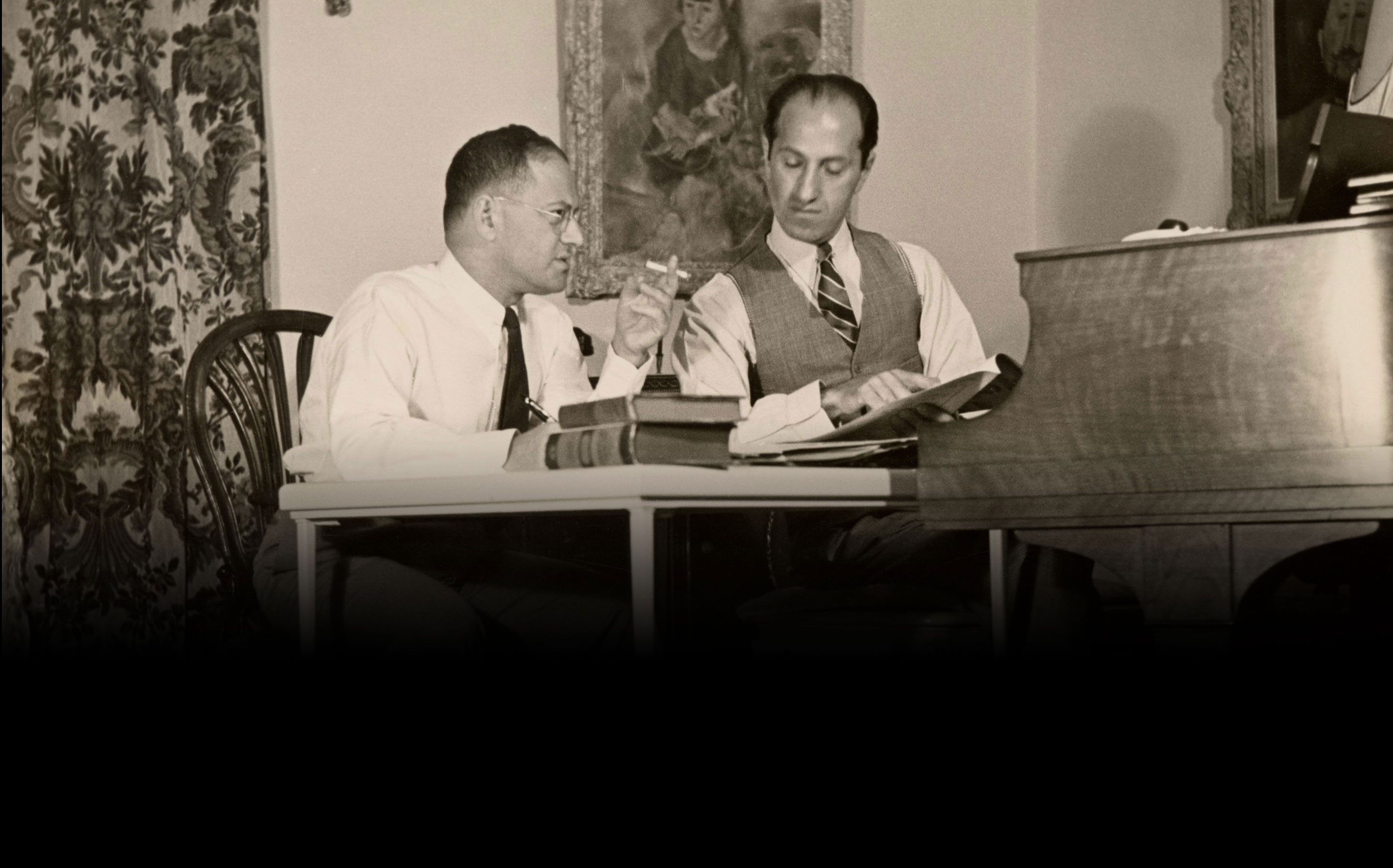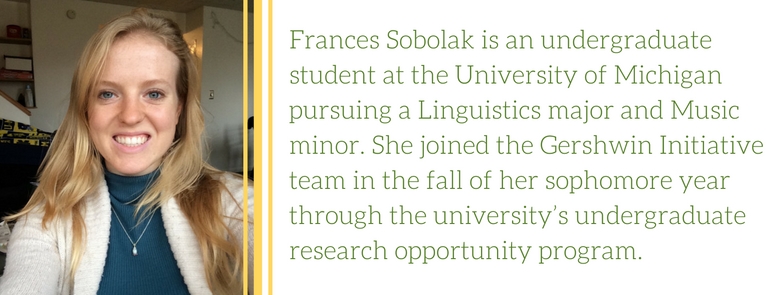Opera Correspondence: Translating English Semantics into Musical Syntax
 Inspired by our From the Archives series, this post will focus on the correspondence, music, and libretto of Act I scene i of Porgy and Bess to see how George interpreted, or translated, DuBose’s natural language (i.e. native, naturally occurring speech) requests in his letter.
Inspired by our From the Archives series, this post will focus on the correspondence, music, and libretto of Act I scene i of Porgy and Bess to see how George interpreted, or translated, DuBose’s natural language (i.e. native, naturally occurring speech) requests in his letter.
By Frances Sobolak
When George Gershwin was inspired to transform DuBose Heyward’s novel Porgy into an opera, DuBose, who had already adapted Porgy into a stage play with his wife Dorothy, agreed to write the libretto. The two men initiated a relationship that so many opera composers and librettists before had entered—a long-distance, collaborative partnership. While George composed in New York, DuBose wrote the libretto in Charleston. The two men, however, might not have anticipated that DuBose’s limited knowledge of musical technique and terminology would prove to be a challenge. Except for the few times George and DuBose met to work on the opera, most of their ideas were conveyed via epistolary, leaving plenty of room for communication errors, misinterpretation of each other’s ideas, and simply ‘I just don’t get it’ moments.
The correspondence between George and DuBose is rich with prosodic descriptions, clarification requests, and staging concerns. This post, the first of a mini-series built around the communication issues between composer and librettist, will focus on the correspondence, music, and libretto of Act I scene i—including George’s preliminary musical sketch and final 1935 orchestral score—to see how George interpreted, or translated, DuBose’s natural language requests in his letter. As a whole, this series will explore how George and DuBose communicated musical themes to one another with limited shared musical terminology and limited face-to-face collaboration.
Each scene DuBose sent to George included a preface, called an “at rise description,” depicting dramatic and musical aspects he envisioned for the scene. On November 12, 1933, DuBose sent George two versions of his libretto for Act I, scene i of Porgy and Bess—one beginning with a slow, jazzy stage, the other beginning with a riotous bang. Additionally enclosed was a letter with musical and staging suggestions for George to consider as he prepared to compose. In this letter, DuBose suggested that the end of the overture, which he termed the “exposition,” merge with the beginning of the first scene accompanied by the “added force of sight and sound,” referring to the stage and lighting effects. He also proposed that, following the transition from the overture, the first scene open with “a regular riot of noise and color” like the theatrical adaptation had. After describing this riotous beginning, DuBose then offered a slower, transitional opening sequence “as the music takes up the theme of jazz from the dance hall piano” that would ultimately be included as a post-overture segue into the opening scene.
This “theme of jazz” proposed in DuBose’s letter is further explained in the libretto’s at rise description: “Jasbo is at the piano playing a low-down blues, and half a dozen couples can be seen locked together dancing in a slow, almost hypnotic rhythm,” which then shifts “from the blues motif to a more sentimental one with this scene,” marking the transition from the onstage jazz piano interlude to what would become the opening lullaby, “Summertime.”
With no other direction for musical composition than these descriptions, George had his work cut out for him. DuBose’s letter and at rise description, while poetically descriptive, contain no “standard” musical terminology that would offer specific musical direction to George. After the overture transition, should his compositional response for the opening scene be allegro or l’istesso tempo—the same tempo as before? Or, referring back to the transitional moment from overture to opening scene, should the beginning of the first scene be faster than the end of the overture? What kind of key signature should George use that would match DuBose’s request for “low-down blues” and the more “sentimental” start of “Summertime”? Certainly not pure C Major. But the resonant, perhaps quarrelsome, E Major? Or the full, harsh sound of B Major? George’s reply on November 25th mostly intimated his need to think and gather “thematic material” before composing (a stage that would take George over a year to complete).
In his early sketch, George decided to complement DuBose’s description of the stage’s “added force of sight and sound” with Píu mosso (faster than the introduction’s beginning at allegro con Brio), as well as a sempre crescendo that transitioned from the end of the overture into the start of the opening scene—selecting those over any number of sufficient tempo markings. Rhythmically, George’s early sketch of the overture’s ending took the shape of four-bar sixteenth-note runs in E Major.
Additionally, George altered DuBose’s wish for a “slow, almost hypnotic rhythm” into allegro con modto [sic] in G Major (faster, perhaps, than what “slow” and “hypnotic” brings to mind) followed by the jazz piano’s allegretto, marked “in a jazz manner.” And when “Summertime” begins in B minor, George modified the rhythm to an alternating eighth-sixteenth note pattern, slowed down to 96 beats per minute. When all of this was transferred to the 1935 official orchestral score, the only change was the allegro con modto [sic] at the start of the first scene to allegro moderato—which suggests both that both DuBose’s descriptions were decipherable to George and George’s composition was to DuBose’s liking.
 Ultimately, though, once George ‘translated’ DuBose’s natural language phrases into musical phrases, would the audience hear DuBose’s requests? After all, “low-down blues” and “regular riot of noise and color” could be represented musically in any number of ways. Something in the semantics of DuBose’s descriptive phrases was a clue for George—and George’s musical decisions based on DuBose’s words and phrases could be viewed as a kind of translation from one language (natural language) to another (music). George, caught in this linguistic dilemma, had to decide not only what DuBose was saying in his letters and at rise descriptions, but how to ensure that his musical ‘translations’ of DuBose’s words would be retrievable to an audience member. Some linguists might argue that there was no inherent reason why George’s music “fit” DuBose’s lyrics. Rather, the music was simply appropriate given the textual context. Whether or not you agree, I believe it is worth discussing. Next time you’re enjoying one of Porgy and Bess’s numbers, ask yourself—what words and interpretation come to mind and might they be the same descriptions DuBose would have wanted?
Ultimately, though, once George ‘translated’ DuBose’s natural language phrases into musical phrases, would the audience hear DuBose’s requests? After all, “low-down blues” and “regular riot of noise and color” could be represented musically in any number of ways. Something in the semantics of DuBose’s descriptive phrases was a clue for George—and George’s musical decisions based on DuBose’s words and phrases could be viewed as a kind of translation from one language (natural language) to another (music). George, caught in this linguistic dilemma, had to decide not only what DuBose was saying in his letters and at rise descriptions, but how to ensure that his musical ‘translations’ of DuBose’s words would be retrievable to an audience member. Some linguists might argue that there was no inherent reason why George’s music “fit” DuBose’s lyrics. Rather, the music was simply appropriate given the textual context. Whether or not you agree, I believe it is worth discussing. Next time you’re enjoying one of Porgy and Bess’s numbers, ask yourself—what words and interpretation come to mind and might they be the same descriptions DuBose would have wanted?
Further Readings:
Swain, Joseph. 1997. Musical Languages. New York City: W. W. Norton & Company, Inc.
Furia, Philip. Ira Gershwin: The Art of the Lyricist. Oxford: Oxford University Press, 1997.



A small quibble, but you really should fix: “Summertime” is in B minor, not D major.
Am I missing something? Are you missing something? What about George’s study with Joseph Schillinger and the construction notes in his notebooks?
Hi, Philip. Thanks for your feedback! These posts are short, and so they can’t cover everything. But I know that Fran will keep Schillinger in mind as she continues to work on this project in other iterations. Be well.
Nice info, thanks for sharing
That’s great. I like reading an article that will make people think. That is really fascinating. Nice written and come with almost all important infos. I would like to see more posts like this . Thanks for sharing this information.
Nice Post. Thanks For Sharing.